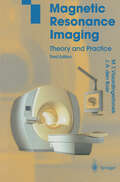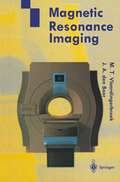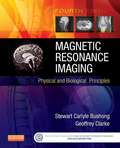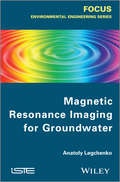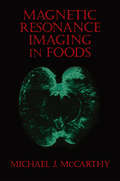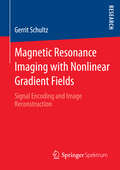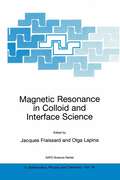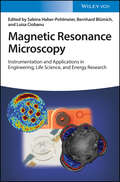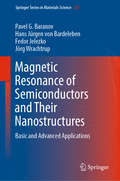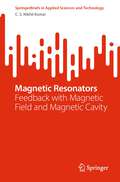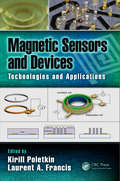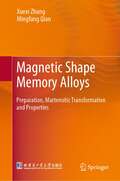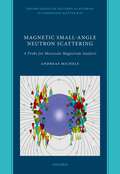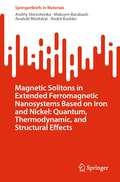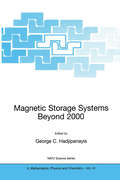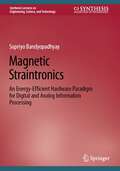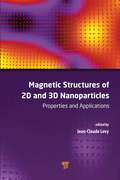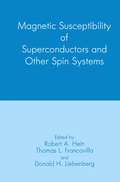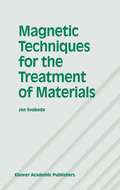- Table View
- List View
Magnetic Resonance Imaging: Theory and Practice
by Marinus T. Vlaardingerbroek Jacques A. BoerPresents an overall analytical treatment of MRI physics and engineering. Special attention is paid to the treatment of intrinsic artefacts of the different sequences which can be described for the different scan methods. The book contains many images, especially showing specific properties of the different scan methods. The methods discussed include RARE, GRASE, EPI and Spiral Scan. The 3rd edition deals with stranger gradient and new RF coil systems, and sequences such as Balanced FFE and q-space diffusion imaging and SENSE.
Magnetic Resonance Imaging: Theory and Practice
by Marinus T. Vlaardingerbroek Jaques A. BoerA comprehensive survey of the analytical treatment of MRI physics and engineering. It brings readers to a position where they are able to cope with the problems that arise when applying MRI to medical problems or when (sub)systems or sequences for new applications are designed. Special attention is paid to the treatment of intrinsic artefacts of the different sequences, which can be described in a mathematically uniform way for the different scan methods. The book contains numerous images, showing specific properties of the different scan methods, which include RARE, GRACE, EPI, and Spiral Scan. The ideal step-up to reach the required level for independent research or development in the field of MRI applications or system design.
Magnetic Resonance Imaging - E-Book: Physical and Biological Principles
by Stewart C. Bushong Geoffrey ClarkeMagnetic Resonance Imaging: Physical and Biological Principles, 4th Edition offers comprehensive, well-illustrated coverage on this specialized subject at a level that does not require an extensive background in math and physics. It covers the fundamentals and principles of conventional MRI along with the latest fast imaging techniques and their applications. Beginning with an overview of the fundamentals of electricity and magnetism (Part 1), Parts 2 and 3 present an in-depth explanation of how MRI works. The latest imaging methods are presented in Parts 4 and 5, and the final section (Part 6) covers personnel and patient safety and administration issues. This book is perfect for student radiographers and practicing technologists preparing to take the MRI advanced certification exam offered by the American Registry of Radiologic Technologists (ARRT). "I would recommend it to anyone starting their MRI training and anyone trying to teach MRI to others." Reviewed by RAD Magazine, June 2015Challenge questions at the end of each chapter help you assess your comprehension.Chapter outlines and objectives assist you in following the hierarchy of material in the text.Penguin boxes highlight key points in the book to help you retain the most important information and concepts in the text.NEW! Two MRI practice exams that mirror the test items in each ARRT category have been added to the end of the text to help you replicate the ARRT exam experience.NEW! Chapter on Partially Parallel Magnetic Resonance Imaging increases the comprehensiveness of the text.NEW! Updated key terms have been added to each chapter with an updated glossary defining each term.
Magnetic Resonance Imaging for Groundwater
by Anatoly LegtchenkoThis book presents the basics of the non-invasive geophysical method for groundwater investigation, called Magnetic Resonance Sounding (MRS) or Surface Nuclear Magnetic Resonance (SNMR), and its practical application to the problems of groundwater localization and aquifer characterization. The method is based on the nuclear magnetic resonance (NMR) phenomenon and is selectively sensitive to groundwater. The main aims of the author are to teach the reader the basic principles of the method as well as to formulate consistent approximate models, leading to reasonably simple inverse problems. Containing an extensive bibliography, numerous practical and numerical examples as well as a detailed presentation of the nuts and bolts of the method based on the long-term experience of SNMR development and practical use, this book is useful for students, scientists and professional engineers working in the field of hydrogeophysics and hydrogeology. Contents 1. SNMR Imaging for Groundwater.2. The Basics of NMR.3. Forward Modeling.4. Inversion.5. Link Between SNMR and Aquifer Parameters.
Magnetic Resonance Imaging for Groundwater
by Anatoly LegtchenkoThis book presents the basics of the non-invasive geophysical method for groundwater investigation, called Magnetic Resonance Sounding (MRS) or Surface Nuclear Magnetic Resonance (SNMR), and its practical application to the problems of groundwater localization and aquifer characterization. The method is based on the nuclear magnetic resonance (NMR) phenomenon and is selectively sensitive to groundwater. The main aims of the author are to teach the reader the basic principles of the method as well as to formulate consistent approximate models, leading to reasonably simple inverse problems. Containing an extensive bibliography, numerous practical and numerical examples as well as a detailed presentation of the nuts and bolts of the method based on the long-term experience of SNMR development and practical use, this book is useful for students, scientists and professional engineers working in the field of hydrogeophysics and hydrogeology. Contents 1. SNMR Imaging for Groundwater.2. The Basics of NMR.3. Forward Modeling.4. Inversion.5. Link Between SNMR and Aquifer Parameters.
Magnetic Resonance Imaging In Foods
by Michael J. McCarthyNuclear magnetic resonance imaging is one of several new experimental tech niques which have rec{ ,tly been applied to food systems. NMR in general and nuclear magnetic resonance imaging are powerful probes of the microscopic and macroscopic changes occurring in foods during processing, storage and utilization. The training that food scientists and food engineers have received in the past has often omitted specific courses in physical chemistry that form the theoretical and practical foundation necessary to fully utilized magnetic resonance experimental techniques. The goal of Magnetic Resonance Imaging in Foods is to introduce food scien tists and food engineers to magnetic resonance imaging and provide a basis for further study. As such the book begins with two chapters of an introductory nature. The first chapter introduces magnetic resonance phenomena, NMR in general, and MRI in detail. Particular emphasis is given to the limitations and typical ranges available for studying particular phenomena, for example, the range of diffusivities that can be studied using commercial grade NMR equipment. Chapter 2 gives a brief introduction to the classical physical model of NMR first introduced by Felix Bloch in 1946 and aspects important to the interpretation of MRI data. This chapter is provided for the researchers and students interested in more details of the basic theory. Chapter 2 can be skipped by those individuals not requiring more information on the basic theory of NMR. The next several chapters of the book are on applications of MRI to food systems.
Magnetic Resonance Imaging in Tissue Engineering
by Mrignayani Kotecha Richard L. Magin Jeremy J. MaoMagnetic Resonance Imaging in Tissue Engineering provides a unique overview of the field of non-invasive MRI assessment of tissue engineering and regenerative medicine Establish a dialogue between the tissue-engineering scientists and imaging experts and serves as a guide for tissue engineers and biomaterial developers alike Provides comprehensive details of magnetic resonance imaging (MRI) techniques used to assess a variety of engineered and regenerating tissues and organs Covers cell-based therapies, engineered cartilage, bone, meniscus, tendon, ligaments, cardiovascular, liver and bladder tissue engineering and regeneration assessed by MRI Includes a chapter on oxygen imaging method that predominantly is used for assessing hypoxia in solid tumors for improving radiation therapy but has the ability to provide information on design strategies and cellular viability in tissue engineering regenerative medicine
Magnetic Resonance Imaging in Tissue Engineering
by Mrignayani Kotecha Richard L. Magin Jeremy J. MaoMagnetic Resonance Imaging in Tissue Engineering provides a unique overview of the field of non-invasive MRI assessment of tissue engineering and regenerative medicine Establish a dialogue between the tissue-engineering scientists and imaging experts and serves as a guide for tissue engineers and biomaterial developers alike Provides comprehensive details of magnetic resonance imaging (MRI) techniques used to assess a variety of engineered and regenerating tissues and organs Covers cell-based therapies, engineered cartilage, bone, meniscus, tendon, ligaments, cardiovascular, liver and bladder tissue engineering and regeneration assessed by MRI Includes a chapter on oxygen imaging method that predominantly is used for assessing hypoxia in solid tumors for improving radiation therapy but has the ability to provide information on design strategies and cellular viability in tissue engineering regenerative medicine
Magnetic Resonance Imaging with Nonlinear Gradient Fields: Signal Encoding and Image Reconstruction
by Gerrit SchultzWithin the past few decades MRI has become one of the most important imaging modalities in medicine. For a reliable diagnosis of pathologies further technological improvements are of primary importance. This study deals with a radically new approach of image encoding. Gradient linearity has ever since been an unquestioned technological design criterion. With the advent of parallel imaging, this approach may be questioned, making way of much a more flexible gradient hardware that uses encoding fields with an arbitrary geometry. The theoretical basis of this new imaging modality – PatLoc imaging – are comprehensively presented, suitable image reconstruction algorithms are developed for a variety of imaging sequences and imaging results – including in vivo data – are explored based on novel hardware designs.
Magnetic Resonance in Colloid and Interface Science (NATO Science Series II: Mathematics, Physics and Chemistry #76)
by J. Fraissard Olga LapinaMagnetic resonance techniques are especially interesting in the study of colloids and interfaces due to their unique ability to elucidate structure, dynamics and function at the atomic and molecular level. This book illustrates the most up to date applications of innovative NMR and EPR techniques, including magnetic resonance imaging and microscopy, to gas-solid and liquid-solid interfaces, organic and biological surfaces, microemulsions, liquid crystals, membranes, structure and dynamics of polymers and micellar systems, and diffusion in heterogeneous systems. A compendium of advanced NMR and EPR techniques and a state of the art description of the power of advanced new methodologies for the study of molecular dynamics and interfaces.
Magnetic Resonance Microscopy: Instrumentation and Applications in Engineering, Life Science, and Energy Research
by Luisa Ciobanu Bernhard Blumich Sabina Haber-PohlmeierMagnetic Resonance Microscopy Explore the interdisciplinary applications of magnetic resonance microscopy in this one-of-a-kind resource In Magnetic Resonance Microscopy: Instrumentation and Applications in Engineering, Life Science and Energy Research, a team of distinguished researchers delivers a comprehensive exploration of the use of magnetic resonance microscopy (MRM) and similar techniques in an interdisciplinary milieux. Opening with a section on hardware and methodology, the book moves on to consider developments in the field of mobile nuclear magnetic resonance. Essential processes, including filtration, multi-phase flow and transport, and a wide range of systems – from biomarkers via single cells to plants and biofilms – are discussed next. After a fulsome treatment of MRM in the field of energy research, the editors conclude the book with a chapter extoling the virtues of a holistic treatment of theory and application in MRM. Magnetic Resonance Microscopy: Instrumentation and Applications in Engineering, Life Science and Energy Research also includes: A thorough introduction to recent developments in magnetic resonance microscopy hardware and methods, including ceramic coils for MR microscopy Comprehensive explorations of applications in chemical engineering, including ultra-fast MR techniques to image multi-phase flow in pipes and reactors Practical discussions of applications in the life sciences, including MRI of single cells labelled with super paramagnetic iron oxide nanoparticles In-depth examinations of new applications in energy research, including spectroscopic imaging of devices for electrochemical storage Perfect for practicing scientists from all fields, Magnetic Resonance Microscopy: Instrumentation and Applications in Engineering, Life Science and Energy Research is an ideal resource for anyone seeking a one-stop guide to magnetic resonance microscopy for engineers, life scientists, and energy researchers.
Magnetic Resonance Microscopy: Instrumentation and Applications in Engineering, Life Science, and Energy Research
by Luisa Ciobanu Sabine Haber-Pohlmeier Bernhard BlumichMagnetic Resonance Microscopy Explore the interdisciplinary applications of magnetic resonance microscopy in this one-of-a-kind resource In Magnetic Resonance Microscopy: Instrumentation and Applications in Engineering, Life Science and Energy Research, a team of distinguished researchers delivers a comprehensive exploration of the use of magnetic resonance microscopy (MRM) and similar techniques in an interdisciplinary milieux. Opening with a section on hardware and methodology, the book moves on to consider developments in the field of mobile nuclear magnetic resonance. Essential processes, including filtration, multi-phase flow and transport, and a wide range of systems – from biomarkers via single cells to plants and biofilms – are discussed next. After a fulsome treatment of MRM in the field of energy research, the editors conclude the book with a chapter extoling the virtues of a holistic treatment of theory and application in MRM. Magnetic Resonance Microscopy: Instrumentation and Applications in Engineering, Life Science and Energy Research also includes: A thorough introduction to recent developments in magnetic resonance microscopy hardware and methods, including ceramic coils for MR microscopy Comprehensive explorations of applications in chemical engineering, including ultra-fast MR techniques to image multi-phase flow in pipes and reactors Practical discussions of applications in the life sciences, including MRI of single cells labelled with super paramagnetic iron oxide nanoparticles In-depth examinations of new applications in energy research, including spectroscopic imaging of devices for electrochemical storage Perfect for practicing scientists from all fields, Magnetic Resonance Microscopy: Instrumentation and Applications in Engineering, Life Science and Energy Research is an ideal resource for anyone seeking a one-stop guide to magnetic resonance microscopy for engineers, life scientists, and energy researchers.
Magnetic Resonance of Semiconductors and Their Nanostructures: Basic and Advanced Applications (Springer Series in Materials Science #253)
by Jörg Wrachtrup Fedor Jelezko Hans Jürgen von Bardeleben Pavel G. BaranovThis book explains different magnetic resonance (MR) techniques and uses different combinations of these techniques to analyze defects in semiconductors and nanostructures. It also introduces novelties such as single defects MR and electron-paramagnetic-resonance-based methods: electron spin echo, electrically detected magnetic resonance, optically detected magnetic resonance and electron-nuclear double resonance – the designated tools for investigating the structural and spin properties of condensed systems, living matter, nanostructures and nanobiotechnology objects. Further, the authors address problems existing in semiconductor and nanotechnology sciences that can be resolved using MR, and discuss past, current and future applications of MR, with a focus on advances in MR methods. The book is intended for researchers in MR studies of semiconductors and nanostructures wanting a comprehensive review of what has been done in their own and related fields of study, as well as future perspectives.
Magnetic Resonators: Feedback with Magnetic Field and Magnetic Cavity (SpringerBriefs in Applied Sciences and Technology)
by C. S. Nikhil KumarThe phase-locking of multiple spin-torque nano oscillators(STNOs) is considered the primary vehicle to achieve sufficient signal quality for applications. This book highlights the resonator's design and its need for feedback for phase locking of STNOs. STNOs can act as sources of tunable microwaves after being phase-locked together. External feedback from a coplanar waveguide placed above an STNO helps ensures coherent single domain oscillations. STNOs placed within magnonic crystal cavities also demonstrate coherent oscillations. Arrays of such cavities provide a route to scale power levels from such nano-oscillators. The book presents numerical and micromagnetics to validate the design.
Magnetic Sensors and Devices: Technologies and Applications (Devices, Circuits, and Systems)
by Laurent A. Francis Kirill Poletkin Krzysztof IniewskiThis book presents in-depth coverage of magnetic sensors in industrial applications. It is divided into three sections: devices and technology for magnetic sensing, industrial applications (automotive, navigation), and emerging applications. Topics include transmission speed sensor ICs, dynamic differential Hall ICs, chopped Hall switches, programmable linear output Hall sensors, low power Hall ICs, self-calibrating differential Hall ICs for wheel speed sensing, dynamic differential Hall ICs, uni- and bipolar Hall IC switches, chopped mono cell Hall ICs, and electromagnetic levitation.
Magnetic Sensors and Devices: Technologies and Applications (Devices, Circuits, and Systems)
by Laurent Francis Kirill Poletkin Krzysztof IniewskiThis book presents in-depth coverage of magnetic sensors in industrial applications. It is divided into three sections: devices and technology for magnetic sensing, industrial applications (automotive, navigation), and emerging applications. Topics include transmission speed sensor ICs, dynamic differential Hall ICs, chopped Hall switches, programmable linear output Hall sensors, low power Hall ICs, self-calibrating differential Hall ICs for wheel speed sensing, dynamic differential Hall ICs, uni- and bipolar Hall IC switches, chopped mono cell Hall ICs, and electromagnetic levitation.
Magnetic Shape Memory Alloys: Preparation, Martensitic Transformation and Properties
by Xuexi Zhang Mingfang QianThis book systematically describes the fundamentals of Magnetic shape memory alloys (MSMAs), with an emphasis on low-dimensional structures such as foams, microwires and micro-particles. The respective chapters address basic concepts and theories, the fabrication of various architectures, microstructure tailoring, property optimization and cutting-edge applications. Taken together, they provide a clear understanding of the correlation between processing and the microstructural properties of MSMAs, which are illustrated in over two hundred figures and schematics. Given its scope and format, the book offers a valuable resource for a broad readership in various fields of materials science and engineering, especially for researchers, students and engineers.
Magnetic Small-Angle Neutron Scattering: A Probe for Mesoscale Magnetism Analysis (Oxford Series on Neutron Scattering in Condensed Matter #16)
by Andreas MichelsThis monograph provides the first extensive treatment of magnetic small-angle neutron scattering (SANS). The theoretical background required to compute magnetic SANS cross sections and correlation functions related to long-wavelength magnetization structures is laid out. The concepts are scrutinized based on the discussion of experimental neutron data. Regarding prior background knowledge, some familiarity with the basic magnetic interactions and phenomena as well as scattering theory is desired. Besides exposing the different origins of magnetic SANS, and furnishing the basics of the magnetic SANS technique in early chapters, a large part of the book is devoted to a comprehensive treatment of the continuum theory of micromagnetics, as it is relevant for the study of the elastic magnetic SANS cross section. Analytical expressions for the magnetization Fourier components allow to highlight the essential features of magnetic SANS and to analyze experimental data both in reciprocal, as well as in real space. Later chapters provide an overview on the magnetic SANS of nanoparticles and so-called complex systems (e.g., ferrofluids, magnetic steels, spin glasses and amorphous magnets). It is this subfield where major progress is expected to be made in the coming years, mainly via the increased usage of numerical micromagnetic simulations (Chapter 7), which is a very promising approach for the understanding of the magnetic SANS from systems exhibiting nanoscale spin inhomogeneity.
Magnetic Solitons in Extended Ferromagnetic Nanosystems Based on Iron and Nickel: Quantum, Thermodynamic, and Structural Effects (SpringerBriefs in Materials)
by Andriy Shevchenko Maksym Barabash Anatolii Minitskyi Andrii KushkoThis book is based on a course of lectures aimed at undergraduate and graduate students studying materials science and welding at the E.O. Paton Institute of Materials Science and Welding National Technical University of Ukraine "Igor Sikorsky Kyiv Polytechnic Institute." The book is divided into four parts, each focusing on various aspects of magnetic solitons in ferromagnetic nanosystems.The first two parts of the book cover the quantum and thermodynamic properties of uniaxial ferromagnetic films with strong magnetic anisotropy and cylindrical nanowires made of different chemical compositions (ferrite-garnet, iron, nickel). These properties are related to the presence of "kink" solitons, which are vertical Bloch lines (BLs) and domain walls (DWs) of transverse type, respectively.The third part of the book discusses the effect of thermal motion of transverse-type DWs on the magnetocaloric effect in cylindrical iron and nickel nanowires. The fourth part of the book explores the conditions that lead to structural transitions between different types of DWs, including transverse, asymmetric, and DWs with a Bloch point (point soliton).Each part of the book is summarized at the end, highlighting the main results presented. Overall, the book is designed to provide students with a comprehensive understanding of magnetic solitons in ferromagnetic nanosystems and their associated quantum, thermodynamic, and structural properties.
Magnetic Storage Systems Beyond 2000 (NATO Science Series II: Mathematics, Physics and Chemistry #41)
by G. C. HadjipanayisAn up-to-date and comprehensive review of magnetic storage systems, including particulate and rigid media, magnetic heads, tribology, signal processing spintronics, and other, future systems. A thorough theoretical discussion supplements the experimental and technical aspects. Each section commences with a tutorial paper, which is followed by technical discussions of current research in the area. Written at a level suitable for advanced graduate students.
Magnetic Straintronics: An Energy-Efficient Hardware Paradigm for Digital and Analog Information Processing (Synthesis Lectures on Engineering, Science, and Technology)
by Supriyo BandyopadhyayThis book covers the new field of straintronics, using strain switched nanomagnets for extremely energy-efficient computing, information processing, communication, and signal generation. Based on well-established CMOS technology, traditional electronics have two significant shortcomings: excessive energy dissipation and volatility, which is the inability to retain information after power has been switched off. Straintronics is more energy-efficient and non-volatile (but also more error-prone), allowing it to eclipse traditional electronics in niche areas that are increasingly attracting attention, such as image processing and probabilistic computing, computer vision, machine learning, neuromorphic networks, probabilistic computing, and belief networks. Magnetic Straintronics: An Energy-Efficient Hardware Paradigm for Digital and Analog Information Processing introduces straintronics and the technology's myriad applications for researchers, engineers, and scientists in electrical engineering, physics, and computer engineering.
Magnetic Structures of 2D and 3D Nanoparticles: Properties and Applications
by Jean-Claude LevyMagnetic nanoparticles appear naturally in rock magnetism together with a large distribution of sizes and shapes. They have numerous applications from nano-size magnetic memories to metamaterials for electromagnetic waves as well as biological applications such as nanosurgery with minimal traumatism. Their long-ranged size- and shape-dependent dipolar interactions provide numerous useful properties. This book describes the preparation as well as the magnetic properties of nanoparticles and also considers 2D dots, nearly spherical samples, elongated samples, and various assemblies of nanoparticles. The authors report the static magnetic structures and dynamic properties of these nanoparticles and the topological defects in 2D and 3D nanoparticles with new examples of S-shaped vortex or antivortex and of bent vortex or antivortex in 3D nanoparticles. The spectrum of magnetic excitations is shown to exhibit the occurrence of gaps, a key for magnonic metamaterial devices. Magnetic excited states are also considered with their coupling to nanoparticle elastic properties.
Magnetic Structures of 2D and 3D Nanoparticles: Properties and Applications
by Jean-Claude Serge LevyMagnetic nanoparticles appear naturally in rock magnetism together with a large distribution of sizes and shapes. They have numerous applications from nano-size magnetic memories to metamaterials for electromagnetic waves as well as biological applications such as nanosurgery with minimal traumatism. Their long-ranged size- and shape-dependent dipolar interactions provide numerous useful properties. This book describes the preparation as well as the magnetic properties of nanoparticles and also considers 2D dots, nearly spherical samples, elongated samples, and various assemblies of nanoparticles. The authors report the static magnetic structures and dynamic properties of these nanoparticles and the topological defects in 2D and 3D nanoparticles with new examples of S-shaped vortex or antivortex and of bent vortex or antivortex in 3D nanoparticles. The spectrum of magnetic excitations is shown to exhibit the occurrence of gaps, a key for magnonic metamaterial devices. Magnetic excited states are also considered with their coupling to nanoparticle elastic properties.
Magnetic Susceptibility of Superconductors and Other Spin Systems
by T. L. Francavilla R. A. Hein D. H. LiebenbergThe workshop entitled Magnetic Susceptibility of Superconductors and other Spin Systems (S4) was held at Coolfont Resort and Health Spa. located near Berkley Springs West Virginia on May 20-23. 1991. There were over sixty attendees. approximately half from the United States. the remainder representing over twelve different countries. The international character of the workshop may be gleaned form the attendee list, included in this volume. The intent of the workshop was to bring together those experimentalists and theoreticians whose efforts have resulted in significant recent contributions to the development and use of the ac susceptibility technique as well as to the interpretation of data obtained from these measurements. Many spirited discussions occurred during and after the presentations. These are reflected in the manuscripts contained in these proceedings. Although camera ready manuscripts were required from all participants at registration, all manuscripts were revised and reflect the lively exchanges that followed each presentation. The small size of the workshop allowed the participants a high degree of flexibility. Consequently when a controversial topic such as "the irreversibility line" emerged, a special session was organized on the spot. At the suggestion of Ron Goldfarb, participants were invited to contribute a one page summary containing their thoughts on the topic. These stand alone contributions were retyped and included as submitted, with only minor editorial changes. These proceedings are intended for those experienced scientists new to the field and graduate students just beginning their research.
